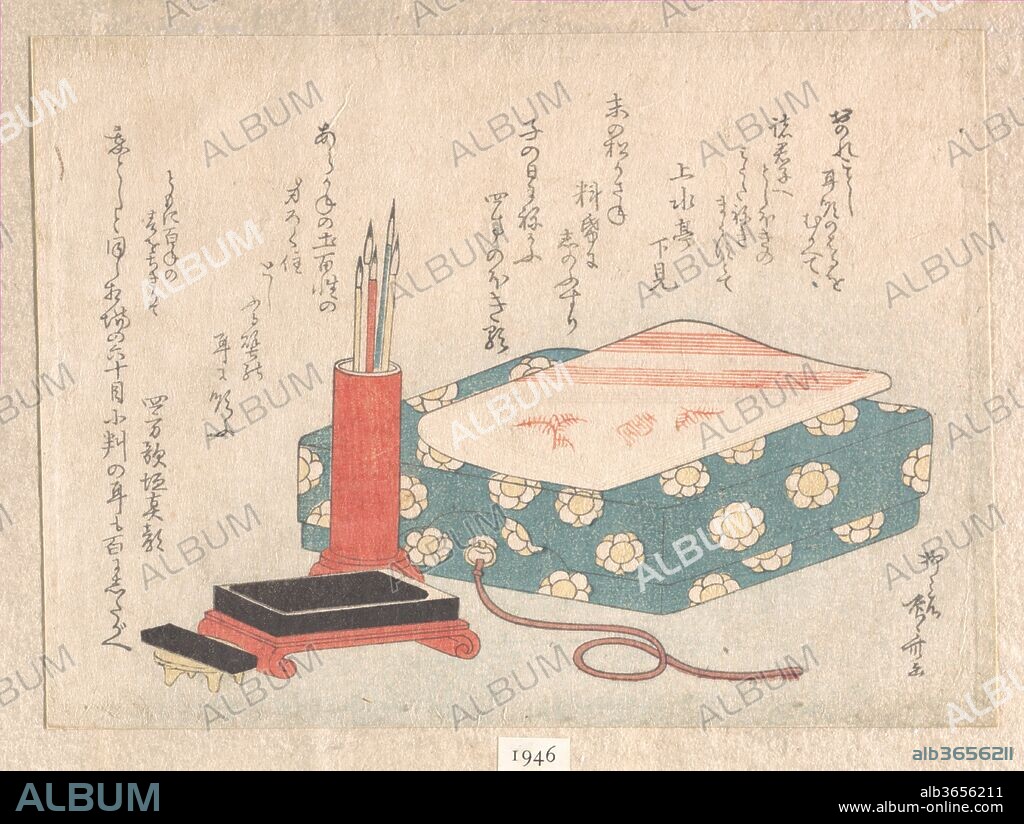alb3656211
RYURYUKYO SHINSAI. Writing Set and Poem Card Box (Shikishi-bako), from Spring Rain Surimono Album (Harusame surimono-jo), vol. 1

|
Add to another lightbox |
|
Add to another lightbox |



Title:
Writing Set and Poem Card Box (Shikishi-bako), from Spring Rain Surimono Album (Harusame surimono-jo), vol. 1
Caption:
Writing Set and Poem Card Box (Shikishi-bako), from Spring Rain Surimono Album (Harusame surimono-jo), vol. 1. Artist: Ryuryukyo Shinsai (Japanese, active ca. 1799-1823). Culture: Japan. Dimensions: 4 15/16 x 6 13/16 in. (12.5 x 17.3 cm). Date: ca. 1805-10.
Surimono are privately published woodblock prints, usually commissioned by poets or poetry groups as a form of New Year's greeting card. The poems, most commonly kyoka (witty thirty-one syllable verse), inscribed on the prints usually include felicitous imagery connected with spring, which in the lunar calendar begins on the first day of the first month. Themes of surimono are often erudite, frequently alluding to Japanese literary classics in both texts and images.
This album belongs to a set of three compiled by Hayashi Tadamasa, the great Parisian dealer of Japanese art. Hayashi arranged the more than four hundred prints in the set on facing leaves according to themes, or in a way that created an attractive arrangement of designs, complementary in both color and shape. The pigments, printing techniques, and paper used for surimono often were of the highest quality, and represent the epitome of late Edo-period woodblock printing.
Technique/material:
Privately published polychrome woodblock prints (surimono) mounted in an album; ink and color on paper
Period:
Edo period (1615-1868)
Museum:
Metropolitan Museum of Art, New York, USA
Credit:
Album / Metropolitan Museum of Art, NY
Releases:
Model: No - Property: No
Rights questions?
Rights questions?
Image size:
4013 x 3020 px | 34.7 MB
Print size:
34.0 x 25.6 cm | 13.4 x 10.1 in (300 dpi)
Keywords:
ALBUMS • ASIA • ASIAN ART • BOOKS • EDO PERIOD (1615-1868) • INK • JAPAN • METROPOLITAN MUSEUM OF ART, NEW YORK, USA • PAPER • PRINTING BLOCKS • PRINTS • PRIVATELY PUBLISHED POLYCHROME WOODBLOCK PRINTS (SURIMONO) MOUNTED IN AN ALBUM; INK AND COLOR ON PAPER • RYURYUKYO SHINSAI • SURIMONO • WOOD BLOCKS
 Pinterest
Pinterest Twitter
Twitter Facebook
Facebook Copy link
Copy link Email
Email

